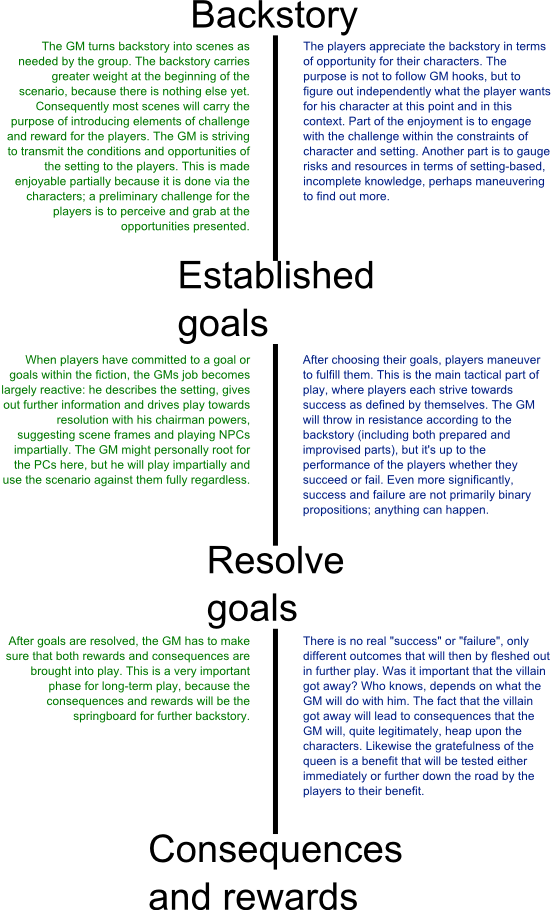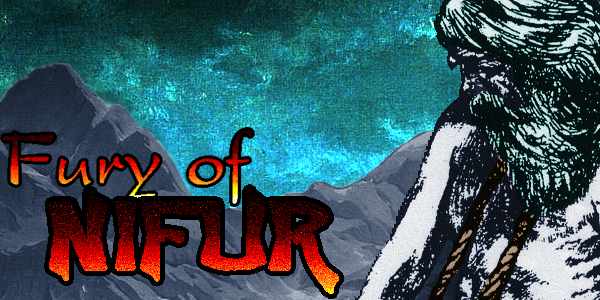As I promised in the previous post, I’m going to write down the scenario we played a while back with Sami, Joonas and Sipi. The intent here is to substantiate my earlier musings about adventure gaming with an example, as well as introduce the dear reader to one possible way of construing an enjoyable gamist (challenge-based, in other words) adventure game. Here’s a cover image made by my brother Jari, linked to the scenario itself:
The actual scenario dragged into a rather longish post, so I’m splitting it into its own page, linked from the title image, above. I also ended up writing a bunch about the method of gamemastering the scenario, so I’ll publish that material here. Such wonder to behold, the non-linear contextual prose of the Internet!
The GMing method
The players of Fury of Nifur have simple duties:
- To engage with the situation of the scenario in a constructive manner, seeking and signifying subject matter that they fancy.
- To encounter their chosen challenges in a honorable manner, accepting triumph or defeat in an equally graceful and sportsmanlike way.
- To strive for the above by controlling the intents and resources of their characters, coordinating with other players and negotiating with the GM over the challenges to be resolved.
The GM, on the other hand, has a bit more involved duties. As can be seen from the scenario itself, this style of challenge-based GMing does not primarily rely on GM-established, carefully balanced challenges. Rather, the idea is that the GM provides a setting with tensions and the players themselves negotiate via the fiction to establish their own goals. Then the GM establishes scenes that might lead to those goals, the group negotiates resolutions for those scenes, and the fall-out then either leads to character success or failure. These consequences then lead the cycle to begin anew. To wit, a diagram is attached.

When talking about “traditional GMing” we’re really talking about a huge history of several separate methods, so it’s best if I list some things that are not part of this particular GMing style:
- The GM does not consider balance of encounters when planning the scenario because he does not know yet what the encounters will be; if a dragon is too powerful for the characters to kill, then the challenges of the story will just have to be negotiated into something lesser. If the kobolds are too easy to kill, then killing them just might not be the real challenge. The dragon can act as a far-off threat the characters do not face, and the kobolds might prove difficult if the real challenge is not killing them, but to avoid them to surprise the dragon. Challenges are not linear zero-sum games of kill-or-be-killed!
- The same holds for the balance of rewards: you don’t need to make sure that killing the troll of Scragtop is amply rewarded, because you don’t have a plot that requires that to happen in the first place. Rather, consider the troll a red herring: players who presume too much or believe the lies of the villagers (who try to feed strangers to the troll so it doesn’t bother the village) will find that the troll doesn’t, after all, hold loot according to encounter level. Still, the players might still find reason enough to kill the troll, so even taking it as a red herring you cackle over when the PCs fall for it is not enough; you need to stop considering the backstory and setting material as challenges to overcome completely. They are not the challenges, only the material that will become such later on.
- The rules system is used intelligently to hop and skip quickly over irrelevancies, focusing on the real challenge moments. If the kobolds above are trivial foes, then roll over them with one combat check or don’t even bring them on the stage.
- The scenes to be framed an challenges to be encountered, not to speak of consequences and rewards, are far from arbitrary. While the GM has initial authority to do what he finds entertaining, the players have a tremendous range of investigation techniques at their disposal to figure out what is going on. The troll of Scragtop, above? The reason why the players don’t just have to guess at the true nature of the troll and trust in the GM not to screw them over is that they very well have opportunity to find out for themselves the truth about the troll.
- When running encounters the GM does not have a particular end-result in mind. He’s not trying to kill the PCs, but he’s not trying to save them either. If you as a GM can’t deal with character death gracefully in the campaign and system context, then modify the system to remove character death instead of cheating. (For example, my primitive-D&D makes it very difficult for characters to die even while failure is easy; it’s still possible to get killed, but it’s rare and dramatic, just like I want it.)
- Bad things that happen to the PCs are justified, just as the good things are: the GM labours under the specific, yet largely unspoken limitation of not just showering the characters with shit or roses for no reason at all. His actions have to be based on the setting, and he has to allow the characters a hand at determining their destiny. Only failure of a player or a character justifies consequences, and only insofar as the consequences reasonably follows from the failure. This issue is only rarely discussed in writing because managing consequences is at the same time utterly necessary and very subjective. Everybody just has to trust the GM not to make a mockery of the game by being unfair in this.

30.12.2007 at 2:28
Marvellous post, Eero. I’m going to be pointing a lot of people to this over time, I can tell.
30.12.2007 at 20:29
Thanks. I’m also pretty happy that I finally managed to verbalize how this particular variant of adventure gaming works. I’d been running a game along these lines for three years or so at the beginning of the decade, but I never really understood myself what I wanted or how the central processes of the game worked. I’m pretty sure that the idea of the challenge-consequence cycle nails it, and now I’m keen to play some more D&D with actual understanding of what I’m doing.
30.12.2007 at 22:29
I keep toying with the hope that 4th edition will have a manageable level of GM prep, at which point I will trade off running D&D for being able to play in some story game sessions. If this comes to pass, I’ll definitely be using this set of techniques.
9.1.2008 at 12:18
[…] Challenge-based adventuring […]
1.3.2008 at 16:42
[…] en ehkä olisi ymmärtänyt ihan niin hyvin ilman blogin olemassaoloa. Esimerkiksi kirjoitukseni haasteseikkailupelaamisesta olisi tuskin koskaan nähnyt päivänvaloa ilman blogi-muotoista […]
20.11.2008 at 18:46
[…] that my primary source of rpg amusement this winter is a new campaign of primitive D&D with challenge-based adventuring techniques. As many of the youngsters I’ve been playing rpgs lately moved towards university […]
27.9.2020 at 0:33
[…] näkemykseni haastevetoisesta D&D-pelaamisesta Eero Tuoviselta yli vuosikymmen sitten (ks. Eeron blogaus aiheesta) ja käsityksiä on vahvistettu sen jälkeen lukuisissa verkkokeskusteluissa. Olen myös […]